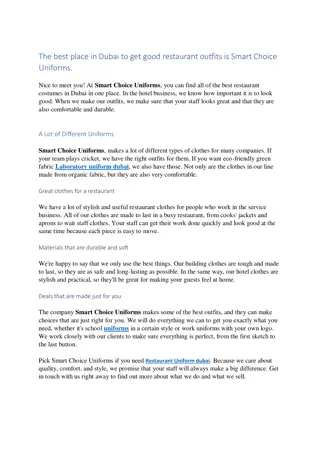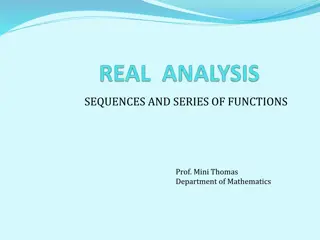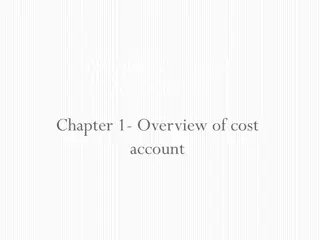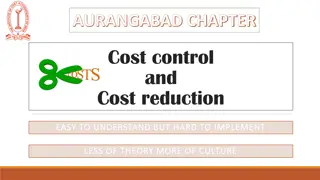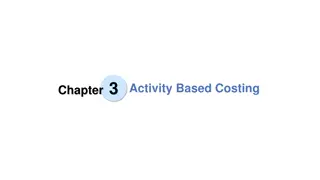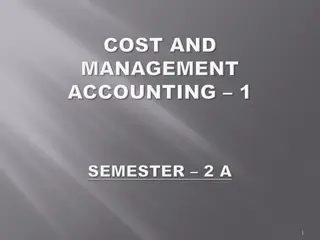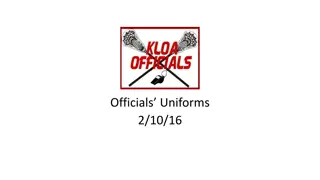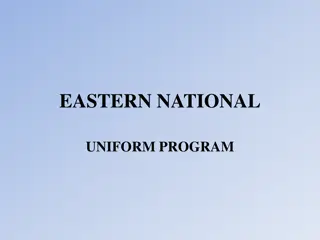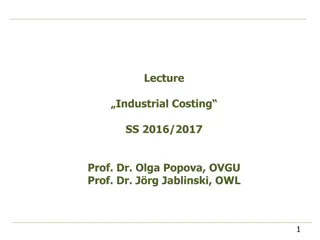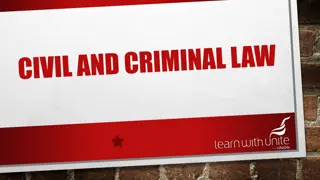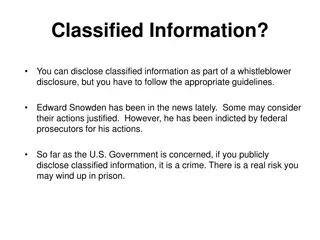Cost Disclosures and Uniform Law Overview
Explore the theory and practice of cost disclosures, cost agreements, estimates, time recording, and billing within the framework of the Uniform Law. Understand the key objectives and changes in cost provisions aimed at ensuring fairness and transparency in legal costs.
Download Presentation

Please find below an Image/Link to download the presentation.
The content on the website is provided AS IS for your information and personal use only. It may not be sold, licensed, or shared on other websites without obtaining consent from the author. Download presentation by click this link. If you encounter any issues during the download, it is possible that the publisher has removed the file from their server.
E N D
Presentation Transcript
How much??!! Theory and practice of cost disclosures, costs agreements, estimates, time recording and billing Peter Moran, Principal 20 July 2017
Overview 1. Regulatory Framework. 2. Disclosure Statements. 3. Cost Agreements. 4. Costs estimates. 5. Time recording. 6. Billing. How Much??!! costing presentation | 20 July 2017 | Page 1
Framework of the Uniform Law The Uniform Law commenced operation in New South Wales and Victoria on 1 July 2015. The Uniform Law originates from a Council of Australian Governments proposal for national legal profession reform in 2009. Legal Profession Uniform Law Application Act 2014 Legal Profession Uniform General Rules. How Much??!! costing presentation | 20 July 2017 | Page 2
Application Uniform Law Part 4.3 (Legal Costs) applies to a matter if the client first instructs the law practice on or after 1 July 2015. The provisions of the old legislation relating to legal costs (other than provisions prescribed by the local regulations) continue to apply to a matter if the client first instructed the law practice in the matter before 1 July 2015. Most of the costs and misconduct disputes of the past three years have been under the old regime. How Much??!! costing presentation | 20 July 2017 | Page 3
Key Objectives of the Uniform Law (s169) The objectives of this Part are: (a) to ensure that clients of law practices are able to make informed choices about their legal options and the costs associated with pursuing those options; (b) to ensure that law practices must not charge more than fair and reasonable amounts for legal costs; and (c) to provide a framework for the assessment of legal costs. How Much??!! costing presentation | 20 July 2017 | Page 4
Key Changes of Cost Provisions 1. 2. 3. 4. 5. 6. 7. 8. Costs must be proportionate. Law Practice must not cause delay. New disclosure requirements. Clients must consent and understand. New exceptions to disclosure requirements. Increased responsibility for principal of bills. Interest on unpaid legal costs. Request for itemised bills and notification in lump sum invoices. How Much??!! costing presentation | 20 July 2017 | Page 5
Why bother with disclosure obligations? Uniform Law VIC LPA Position s178(2) UL CONSEQUENCES OF NON-DISCLOSURE s3.4.17(4) LPA (1) If a law practice contravenes the disclosure obligations of this Part: (a) the costs agreement concerned (if any) is void; and (b) the client not required to pay the legal costs until assessed or any costs dispute has been determined by the designated local regulatory authority; and (c) the law practice must not commence or maintain proceedings for the recovery of any or all of the legal costs until they have been assessed or any costs dispute has been determined ; and (d) the contravention is capable of constituting unsatisfactory professional conduct or professional misconduct. Reduction of legal costs: On assessment If a law practice does not disclose to a client or an associated third party payer anything required by this Division to be disclosed, then, on an assessment of the relevant legal costs, the amount of the costs may be reduced by an amount considered by the costs assessor to be proportionate to the seriousness of the failure to disclose. NB: Victorian version of designated local regulatory authority is the Victorian Legal Services Board + Commissioner How Much??!! costing presentation | 20 July 2017 | Page 6
Main Disclosure Requirements Uniform Law VIC LPA Position s174(1) UL s3.4.9(1)(a) & (c) LPA A law practice (1) A law practice must disclose to a client in accordance with this Division: (a) must, when or as soon as practicable after instructions are initially given in a matter, provide the client with information disclosing the basis on which legal costs will be calculated in the matter and an estimate of the total legal costs; and (a) the basis and (c) an estimate of the total legal costs if reasonably practicable or, if that is not reasonably practicable, a range of estimates of the total legal costs and an explanation of the major variables that will affect the calculation of those costs (b) must, when or as soon as practicable after there is any significant change to anything previously disclosed under this subsection, provide the client with information disclosing the change, including information about any significant change to the legal costs that will be payable by the client together with the information referred to in subsection (2). s3.4.16 LPA A law practice must, in writing, disclose to a client any substantial change to anything included in a disclosure already made under this Division as soon as is reasonably practicable after the law practice becomes aware of that change. How Much??!! costing presentation | 20 July 2017 | Page 7
Additional Disclosure Requirements Uniform Law VIC LPA Position s174(2) UL s3.4.9 LPA Information provided under (a) subsection (1)(a) must include information about the client's rights (i) to negotiate a costs agreement with the law practice; and (ii) to negotiate the billing method (for example, by reference to timing or task); and (iii) to receive a bill from the law practice and to request an itemised bill after receiving a bill that is not itemised or is only partially itemised; and (iv) to seek the assistance of the designated local regulatory authority in the event of a dispute about legal costs; or (b) subsection (1)(b) must include a sufficient and reasonable amount of information about the impact of the change on the legal costs that will be payable to allow the client to make informed decisions about the future conduct of the matter. To negotiate costs agreement (s3.4.9(b)(i)) Receive a bill (s3.4.9(1)(b)(ia)) Request an itemised bill within 30 days (s3.4.9(1)(b)(ii)) NB: Other disclosure requirements no longer prescribed NB: Victorian version of designated local regulatory authority is the Victorian Legal Services Board + Commissioner How Much??!! costing presentation | 20 July 2017 | Page 8
Disclosure regarding Settlement of Litigious Matter (s177) If you negotiate a settlement of a litigious matter on behalf of a client, before the settlement is executed you must disclose a reasonable estimate of the amount of legal costs payable by the client if the matter is settled (including any legal costs of another party), and a reasonable estimate of any contributions towards those costs likely to be received from another party. How Much??!! costing presentation | 20 July 2017 | Page 9
When is a disclosure statement required? Section 170 of the Uniform Law. See flow chart. How Much??!! costing presentation | 20 July 2017 | Page 10
When is a disclosure statement required? Template where costs less than $3,000 section 174(5) See template. How Much??!! costing presentation | 20 July 2017 | Page 11
Ongoing Disclosure (s171(1)(b)) A law practice must, when or as soon as practicable after there is any significant change to anything previously disclosed under this subsection, provide the client with information disclosing the change, including information about any significant change to the legal costs that will be payable by the client together with the information referred to in subsection (2). How Much??!! costing presentation | 20 July 2017 | Page 12
Anti-Voiding The Rule 72A gives law practices an opportunity to rectify contravention of the disclosure obligations within a strict time frame. The costs agreement will not be void if law practices have: taken reasonable steps to comply with their disclosure requirements; and rectified a contravention within 14 days of becoming aware of it by providing the necessary costs disclosure information. How Much??!! costing presentation | 20 July 2017 | Page 13
How to Provide an Estimate of Legal Costs When initial instructions are given, or as soon as practicable afterwards, you must give the client a written disclosure of the estimated total legal costs, including the basis for calculating costs. The Legal Services Council expresses its view that an estimate of the total legal costs in a matter include a range. The definition of total legal costs in this context includes professional fees, any disbursements and GST, which should be separately identified (cf s174(9)). How Much??!! costing presentation | 20 July 2017 | Page 14
So, how do we estimate how long a piece of string is? Some practical tips from the costing world: 1. Focus on the precise instructions given and therefore the scope of the retainer at the time the estimate is given. 2. Estimate the total costs (i.e. include GST and disbursements) of just that precise retainer and reduce that to writing. 3. Until the full scope is known, don t reduce to writing the estimate of the total matter, but provide one verbally (in which case you can provide a range in doing so). 4. As soon as the scope of the retainer changes, a new estimate of total costs must be provided in writing. How Much??!! costing presentation | 20 July 2017 | Page 15
So, how do we estimate how long a piece of string is? Part 2 LSC RPA Alert #22 1. In simple matters, a first estimate followed by revised estimate following a significant change is satisfactory. 2. In a complex matter, estimates for different stages can be provided but each stage should have a description of the factors that would influence the estimate of that stage. 3. Each stage should have a description of the factors that would influence the estimate for that stage. Essential elements of proper costs disclosure include monitoring and updating the estimate as the work progresses, and keeping the client informed (including as changes occur). How Much??!! costing presentation | 20 July 2017 | Page 16
Costs Agreements Not strictly required if a disclosure statement is not required. But any client of law practice (whether or not disclosure is required under part 4.3) has the right to require and to have a negotiated costs agreement by law (s179). A cost agreement may be enforced in the same way as any other contract (s184). Therefore principles of contract law continue to apply to costs agreements, i.e: Offer Acceptance Consideration Certainty of terms Mutuality of obligation Competency and Capacity How Much??!! costing presentation | 20 July 2017 | Page 17
Requirements of a Valid Agreement (s180) Section 180(1) of the Uniform Law sets out who can be a party to a costs agreement. A cost agreement must be written or evidenced in writing. A costs agreement may consist of a written offer that is accepted in writing or by other conduct, except for conditional costs agreements which must always be accepted in writing (s180(3)). Other conduct referred to in section 180(3) may include a telephone conversation from the client accepting the offer, although the law practice may need to produce a file note demonstrating acceptance by the client. You cannot contract out of the costs assessment process (s180(4)). How Much??!! costing presentation | 20 July 2017 | Page 18
What if my cost agreement is void? LPA position: s. 3.4.19 Subject to Division 2, legal costs are recoverable (a) under a costs agreement made in accordance with Division 5 or the corresponding provisions of a corresponding law; or (b) if paragraph (a) does not apply, in accordance with an applicable practitioner remuneration order or scale of costs; or (c) if neither paragraph (a) nor (b) applies, according to the fair and reasonable value of the legal services provided. Note: See section 3.4.44(2) for the criteria that are to be applied on a costs review to determine whether legal costs are fair and reasonable. No provision under the Uniform Law. How Much??!! costing presentation | 20 July 2017 | Page 19
Time Recording Quiz questions perusals, scanning, examinations, descriptions and scales. How Much??!! costing presentation | 20 July 2017 | Page 20
Time Recording When recording time, ensure that the file itself evidences why a task took a certain amount of time and, if the file does not do this, provide a file note or an explanation in the time entry. The longer the task, the more an explanation may be necessary. How Much??!! costing presentation | 20 July 2017 | Page 21
Time Recording fair and reasonable Section 172 172 Legal costs must be fair and reasonable (1) A law practice must, in charging legal costs, charge costs that are no more than fair and reasonable in all the circumstances and that in particular are (a) proportionately and reasonably incurred; and (b) proportionate and reasonable in amount. (2) In considering whether legal costs satisfy subsection (1), regard must be had to whether the legal costs reasonably reflect (a) the level of skill, experience, specialisation and seniority of the lawyers concerned; and (b) the level of complexity, novelty or difficulty of the issues involved, and the extent to which the matter involved a matter of public interest; and (c) the labour and responsibility involved; and How Much??!! costing presentation | 20 July 2017 | Page 22
Time Recording fair and reasonable Section 172 cont. (d) the circumstances in acting on the matter, including (for example) any or all of the following (i) the urgency of the matter; (ii) the time spent on the matter; (iii) the time when business was transacted in the matter; (iv) the place where business was transacted in the matter; (v) the number and importance of any documents involved; and (e) the quality of the work done; and (f) the retainer and the instructions (express or implied) given in the matter. How Much??!! costing presentation | 20 July 2017 | Page 23
What things cant you record time (i.e. charge) for? 1. Preparing or giving a bill - s191. 2. Anything that isn t fair or reasonable?? 3. Value billing? How Much??!! costing presentation | 20 July 2017 | Page 24
Billing (s186 193) Lump sum or itemised (interim) see Piper Alderman v Smoel [2017] VSCA 42. Notification of client s rights s192 avenues for dispute and time limits. Responsible principal for bill must sign all invoices. Proceedings can t be commenced to recover cots unless a complaint bill has been provided s.194. Notification of the right to charge a higher amount stated on itemised bill if requested, Rule 74. Request for itemised bill must be made within 30 days of lump sum bill being issued. A law practice must comply with this request within 21 days. How Much??!! costing presentation | 20 July 2017 | Page 25
Interest on Unpaid Legal Costs Rule 75 - Cash Rate Target as at the relevant date, increased by 2 percentage points. Cannot charge interest on a bill given more than 6 months after the completion of the matter s.195(5). A law practice can charge interest on unpaid legal costs if the costs are unpaid 30 days or more after the law practice has given a bill. How Much??!! costing presentation | 20 July 2017 | Page 26
Rule 74 (1) If the total amount of the legal costs specified in an itemised bill given by a law practice exceeds the amount previously specified by the law practice in a lump sum bill for the same matter, the additional costs may be recovered by the law practice only if: (a) when the lump sum bill was given, the law practice made an appropriately worded disclosure in writing to the client indicating that the total amount of the legal costs specified in any itemised bill may be higher than the amount specified in the lump sum bill, and (b) the costs are determined to be payable after a costs assessment or after a binding determination under section 292 of the Uniform Law. How Much??!! costing presentation | 20 July 2017 | Page 27
Costs Disputes on or after 1 July 2015 Costs disputes where client first instructs solicitor on or after 1 July 2015 Part 4.3 of the Legal Profession Uniform Law 2014 applies to costs disputes to the Costs Court. There are three ways of attempting to resolve a costs dispute: 1. A client may complain to the Legal Services Commissioner if the bill is under $100,000 or if more than that amount and the amount in dispute is less than $10,000. 2. If the client is out of time to complain to the Legal Services Commissioner, or the bill is over $100,000, the client may also commence proceedings in the Costs Court. 3. In any matter, no matter what the amount of the bill of costs is, the client may apply to the Costs Court to assess a lawyer's bill of costs, even if the amount in dispute is less than $100,000. A lawyer may also issue proceedings in the Costs Court if there is a dispute and if the client fails to pay a bill of costs. How Much??!! costing presentation | 20 July 2017 | Page 28
Application for Costs Assessment Assessment of legal costs are to be conducted by costs assessors in accordance with Part 4.3 (s199). Under section 199(2), on a costs assessment, the costs assessor must determine: whether or not a valid costs agreement exists; whether legal costs are fair and reasonable; and the amount of legal costs (if any) that are payable. Client has 12 months from the date of the last invoice to assess a whole or part of legal costs. How Much??!! costing presentation | 20 July 2017 | Page 29

 undefined
undefined



 undefined
undefined








